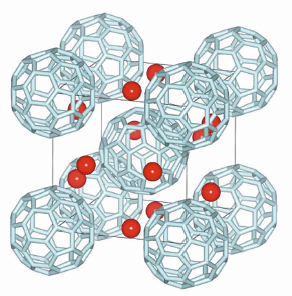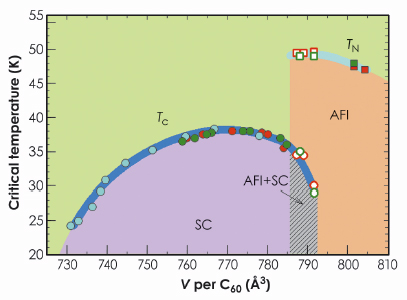- Home
- Users & Science
- Scientific Documentation
- ESRF Highlights
- ESRF Highlights 2009
- Structure of materials
- Non-BCS high-Tc superconductivity in the ordered cubic superconductor Cs3C60
Non-BCS high-Tc superconductivity in the ordered cubic superconductor Cs3C60
C60-based solids have long been recognised as archetypal examples of molecular superconductors with Tc as high as 33 K. The superconducting Tc of face-centred cubic (fcc) A3C60 (A = alkali metal) increases monotonically with the inter-C60 separation, which is in turn controlled by the intercalant’s A+ size. However, following such discoveries many years ago, established fulleride chemistry has failed to deliver new materials.
 |
|
Fig. 57: Crystal structure of A15 Cs3C60 (space group Pm-3n) based on bcc anion packing with orientationally ordered C603- anions. The lower bcc packing density offers more spacious sites (with four fulleride neighbours) for the large Cs+ (red) when compared to fcc A3C60. |
Recent work in our laboratories based on new synthetic ideas coupled with structural and electronic property measurements has made it possible to advance in this area. Firstly, we developed synthetic protocols employing new solvents to access hyper-expanded alkali fullerides near the metal-insulator boundary and at previously inaccessible intermolecular separations [1]. Then we used the accumulated synthetic expertise aided by in situ structural characterisation on beamline ID31 specifically to target high-symmetry (retaining t1u orbital degeneracy in the solid) fullerides with varying C60 orientation and packing. This approach culminated in the discovery of bulk superconductivity under pressure at 38 K in bcc-structured A15 Cs3C60 (Figure 57), the highest Tc known for any molecular material [2]. This is the first example of a superconducting C603- fulleride with non-fcc sphere packing. This single non-fcc material has a higher Tc than all the fcc A3C60 fullerides studied previously. Higher Tcs are therefore possible once the constraint of working in fcc systems is broken. Moreover, the electronic ground state in competition with superconductivity not only contains magnetic moments localised on the C603- anions but is antiferromagnetically ordered with TN = 46 K. The antiferromagnetic insulator-superconductor transition maintains the threefold degeneracy of the active orbitals in both competing electronic states, and is thus a purely electronic transition to a superconducting state with a Tc dependence on pressure-induced changes of anion packing density that is not explicable by BCS theory (Figure 58).
 |
|
Fig. 58: Electronic phase diagram of A15 Cs3C60 showing the evolution of TN (squares) and Tc (circles) and thus the isosymmetric transition from the ambient pressure AFI state to the high-pressure SC state as a function of volume occupied per fulleride anion, V, at 14.6 K. Open symbols represent data in the AFI-SC coexistence regime. |
The high symmetry of the C60 building block imposes a robust cubic three-dimensional structure on A15 Cs3C60, free of positional, chemical, or orientational disorder, with a fixed charge state in which magnetism is transformed into superconductivity solely by changing an electronic parameter, the extent of overlap between the outer wavefunctions of the anions. The pressure-induced transition from a localised electron AFI to a superconductor with two distinct dependences of Tc on packing density is purely electronic in nature, driven by increased overlap between the C603- anions and the associated enhanced tendency to delocalise the t1u electrons. The unconventional nature of the superconducting state that emerges from the AFI can be associated with its proximity to the metal-insulator transition. In this case, the conventional Fermi liquid theories are not valid, and quasi-localised effects produced by electronic correlation, which enhances the role of intramolecular Jahn-Teller (electron-phonon) and Hund’s rule (electron-electron) coupling, are directly controlled by the persistent orbital degeneracy in both the insulating and superconducting states. The observed maximum in Tc(P) is consistent with theoretical treatments [3] that explicitly take account of the orbital degeneracy and the repulsion between the electrons as well as the classical electron-phonon coupling. These effects are not seen in conventional fcc A3C60 systems, which are too far from the metal-insulator transition for differences from the BCS predictions of the dependence of Tc on N(Ef) to become apparent. Therefore, A15 Cs3C60 emerges as an ideal material for understanding the interactions producing superconductivity in structurally and chemically complex correlated electron systems such as the cuprates and oxypnictides, as it allows the isolation of the influence of only electronic factors without any other complications.
References
[1] A.Y. Ganin, Y. Takabayashi, C.A. Bridges, Y.Z. Khimyak, S. Margadonna, K. Prassides and M.J. Rosseinsky, J. Am. Chem. Soc. 128, 14784 (2006).
[2] A.Y. Ganin, Y. Takabayashi, Y.Z. Khimyak, S. Margadonna, A. Tamai, M.J. Rosseinsky and K. Prassides, Nature Mater. 7, 367 (2008).
[3] M. Capone, M. Fabrizio, C. Castellani and E. Tosatti, Rev. Mod. Phys. 81, 943 (2009).
Principal publication and authors
Y. Takabayashi (a), A.Y. Ganin (b), P. Jegliã (c), D. Arãon (c), T. Takano (d), Y. Iwasa (d), Y. Ohishi (e), M. Takata (e), N. Takeshita (f), K. Prassides (a) and M.J. Rosseinsky (b), Science 323, 1585-1590 (2009).
(a) Department of Chemistry, Durham University (UK)
(b) Department of Chemistry, University of Liverpool (UK)
(c) Institute JoÏef Stefan, Ljubljana (Slovenia)
(d) Institute for Materials Research, Tohoku University, Sendai (Japan)
(e) Japan Synchrotron Radiation Research Institute, SPring-8, Hyogo (Japan)
(f) National Institute of Advanced Industrial Science and Technology, Tsukuba (Japan)



